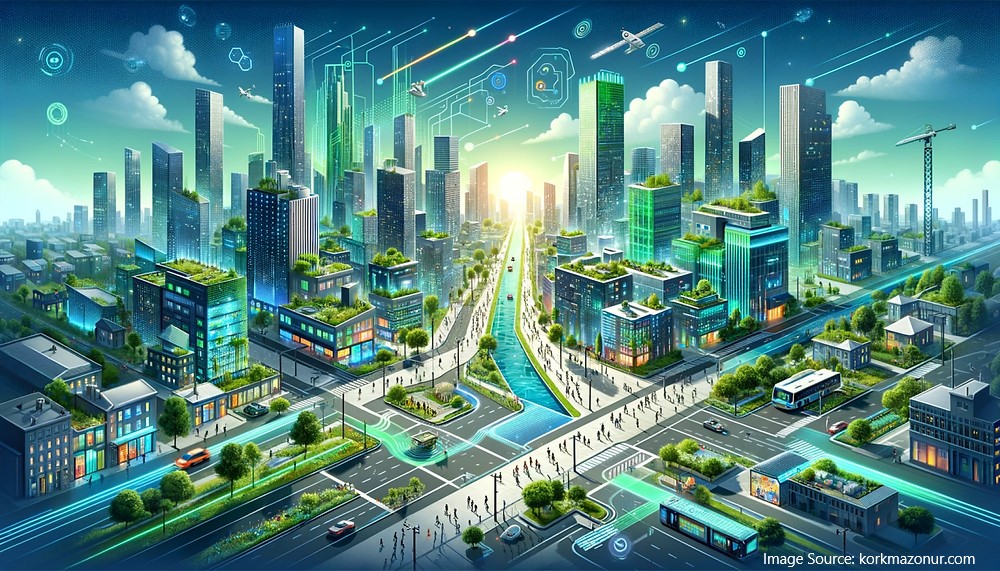
The integration of Artificial Intelligence (AI) with Building Information Modeling (BIM) is reshaping the architecture, engineering, and construction (AEC) industries, setting new standards in project efficiency, design innovation, and lifecycle management. Combining AI’s data-driven capabilities with BIM’s digital representations allows for improved predictive analysis, automation, collaboration, and sustainability across the project lifecycle. This powerful combination transforms BIM from a static digital model into an intelligent system that continuously learns and optimizes construction processes.
Enhanced Predictive Analysis and Risk Management:
One of the most impactful ways AI enhances BIM is through predictive analysis, enabling project teams to proactively manage risks. Using historical project data and machine learning algorithms, AI can analyze patterns and predict future project outcomes. Crucial in anticipating delays, resource shortages, or cost overruns. For example, AI can recommend ordering earlier to avoid project holdups. Similarly, analysing weather trends can help project managers schedule outdoor work during optimal conditions, reducing weather-related delays.
AI-powered BIM models allow for a proactive approach to construction planning and risk mitigation. By identifying potential challenges before they arise, project teams can make informed adjustments, reducing unexpected costs and delays. This predictive element significantly improves project timelines, safety, and efficiency, turning BIM into an active decision-support system rather than a static model.
Automation of Design and Optimization:
AI integration in BIM also automates and optimizes design processes, making it easier to explore multiple design options quickly. With generative design capabilities, AI can produce numerous design iterations based on constraints like budget, structural requirements, and environmental factors. For instance, an architect can input specific parameters, and AI algorithms will generate optimized layouts, allowing architects and engineers to select the best options from a wide range of automatically generated solutions, encompassing energy efficiency, sustainability, and cost-effectiveness.
AI can simulate how different designs will impact energy usage or daylighting and provide options that maximize efficiency while minimizing costs. This capability significantly reduces the time needed for design iterations, allowing architects to make data-driven design choices that are both innovative and practical.
Real-Time Project Tracking and Progress Monitoring:
AI integration within BIM models improves real-time tracking of construction projects, providing on-site teams with immediate insights into project status and identifying issues as they arise. By combining IoT sensors, drones, and AI-driven analytics, construction managers can monitor site conditions and receive alerts for any deviation from the project plan. For example, drones can capture high-resolution images of the construction site, and AI algorithms can compare them to the BIM model to identify discrepancies, such as structural misalignment or potential safety hazards.
With AI-enhanced BIM, construction managers and stakeholders have a continuous flow of information about the project’s progress. This visibility helps teams address problems before they escalate, keeping projects on schedule and within budget. Real-time tracking also improves safety by identifying and mitigating risks on-site.
Enhanced Collaboration and Data-Driven Decision-Making:
The combination of AI and BIM improves collaboration among stakeholders by making complex data accessible and actionable. AI algorithms can analyze vast amounts of data generated throughout the project lifecycle, filtering relevant information and presenting insights to project managers, architects, and clients. With natural language processing (NLP) capabilities, AI allows users to query BIM data conversationally, simplifying access for non-technical stakeholders and facilitating communication.
This level of collaboration is essential for ensuring that everyone involved in the project understands its progress and any potential issues. It also supports data-driven decision-making, as project teams can analyze historical data and past project outcomes to refine their strategies and improve efficiency on future projects. By using AI to derive insights from BIM data, teams can continuously learn and adapt, improving project outcomes and stakeholder satisfaction.
Lifecycle Management and Digital Twins:
The integration of AI with BIM plays a pivotal role in lifecycle management, providing value well beyond the construction phase. Once a building is complete, BIM data can be used to create a digital twin—a virtual model that mirrors the physical structure and updates in real time. This model allows facility managers to monitor building performance, detect inefficiencies, and predict maintenance needs, enabling facility managers to act proactively.
This predictive maintenance capability extends asset life, reduces operational costs, and helps maintain optimal performance. Digital twins powered by AI and BIM offer a comprehensive view of the building’s lifecycle, making it easier to manage resources and reduce energy consumption, which is increasingly important for sustainability goals.
Sustainability and Environmental Impact:
AI-enhanced BIM models are instrumental in advancing sustainable construction practices. AI can simulate and optimize the environmental impact of different design options, allowing architects and engineers to choose materials and designs that minimize energy consumption and reduce carbon emissions. By evaluating factors like natural lighting, insulation efficiency, and material sourcing, AI can guide the project team toward decisions that reduce the building’s overall environmental footprint.
In addition, AI can predict how the building will perform under various environmental conditions, helping architects create structures resilient to climate changes or natural disasters. This approach supports sustainable development by creating buildings that are not only energy-efficient but also designed to withstand long-term environmental challenges.
AI enhances BIM’s capabilities, turning it into a dynamic tool that actively supports design optimization, predictive maintenance, and real-time project management. By enabling data-driven decision-making and proactive risk management, AI-powered BIM helps construction teams deliver projects more efficiently, safely, and sustainably. As AI technology continues to advance, its applications within BIM are likely to expand, making the AEC industry more adaptable, innovative, and sustainable. Setting new standards for how buildings are designed, constructed, and managed. AI in BIM not only improves immediate project outcomes but also paves the way for a future of smarter, more resilient built environments.
Draftech – Your Project, Our Expertise
Testimonials
Thank you for all your efforts on our projects; they have been an invaluable contribution to their success. We look forward to working with you on future projects.
Ian Ferguson MPM Group
Jess and Karl at Draftech were amazing. The communication from the start was prompt, and the entire process was extremely easy. We needed their knowledge on Air Schematics, and they had made one up for our buildings that we service. Thanks so much, and we will be using you guys in the future. Cheers, Air Control Australia.
Greg Colebrook AirControl Australia
With Draftech’s thorough understanding of building services modelling and close attention to detail, Forth has been afforded the opportunity to outsource some of our BIM projects with absolute confidence in the accuracy of the final product.
Gary Murdoch Forth Consulting
Very professional and efficient organization. Delivered a great product to a tight deadline.
ACE Power
Karl and the team are very professional and have a vast knowledge of BIM coordination.
Dwayne Willaims Babinda Electrics
We had multiple large projects with tight deadlines and needed a company we could trust. The teams delivery, attention to detail and understanding of what is being designed is always executed to a high standard.
Martin O’Donovan Envar Engineers
Draftech offered a flexible and reliable approach to working collaboratively with our team. They met our expectations and quality requirements and also offered up new ideas.
Draftech have proven to be a valuable and trustworthy resource and we will continue to work with Draftech on other projects.
Simon Marsden Umow Lai
Draftech is different from others in the professionalism and features they provide.
The ability to walk through projects in real time online provides invaluable insight into problem areas and helps provide an efficient resolution on the spot without many phone calls, emails and the necessity for us to paw through countless drawings to understand the issues.
Todd Morris Manager - Air mech
Draftech were put forward to FIP Electrical as the solution to Coordinate, Model, carry out clash detection, provide Electrical Services Shop Drawings, as built documentation and completed electrical model.
Simon Thorpe FIP Electrical
In close collaboration Draftech set up all our systems and model deliverables. In this process Draftech have proven to be a valuable resource for us and demonstrated commitment, understanding and professionalism.
David Skelley DJCoalition
Draftech’s attention to detail and proactive nature throughout the project assisted us in identifying issues before becoming evident on site, saving us both time and unexpected costs.
Matt Payne PJM Engineering Services
They delivered very high quality Revit models and associated 2D documentation at key milestones, working to a tight budget and in strict accordance with the Architects’ BIM requirements.
Peter Thomas Geoff Hesford
We found Draftech’s work to be of high standard and the team delivered exactly as agreed, in fact, when we considered the project complete, Draftech put further resources into the project as they were not satisfied.
John Johnson Beca
Engaging Draftech during design gave us the tools to make smart decisions.
Hansen Yuncken Design Manager - Michael Harkins
The drafting service is timely, reliable and fit for purpose for the built environment.
Peter Harvey Harvey Industries
Draftech stands apart from other drafting services that we have previously used in their attention to detail and ability to adapt to the individual client’s requirements.
Doug Holt McCaig Aircon
I can confidently recommend Draftech as a solid and reliable supplier, and experts in their field. I look forward to working with them again in the near future.
Chris Behan Norman Disney & Young
After seeing the benefits Draftech provided us on the Townsville Hospital Redevelopment we have set up a relationship with Draftech and intend to continue to use their BIM knowledge and skills for our future projects.
Brad Lund Energy Power Systems
Draftech has no competition as they are in a class of their own.
John Boyes Babinda Electrics
Draftech Developments Drafting and Design Capabilities, in conjunction with their outstanding level of Client service and support has provided great solutions to our engineering and Drafting Design portions within our Gorgon Barrow Island Project.
Aaron Hazelton Applied Electro Systems Pty Ltd
Draftech set up necessary systems and workflows very quickly, but also setup auditable estimating and weekly cost tracking processes that we utilised, requiring little maintenance.
TOM PURDON MPM GROUP
































